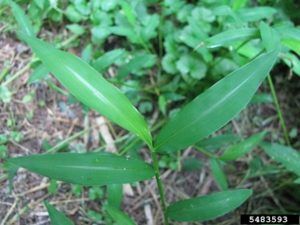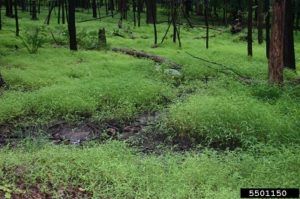This Fall, Keep an Eye Out for Japanese Stiltgrass
At MUCC, we combine education, advocacy and on-the-ground work to conserve and protect our natural resources. Speaking to all who read this blog, our rich natural resources are under a constant threat from invasive species. As stewards of our land, it is our job to become educated about these invasive species and take appropriate action to manage and eradicate them. We at MUCC support Michigan’s Terrestrial Invasive Species Management Plan so that Michigan citizens may continue to enjoy their natural resources for generations to come. This blog post highlights one invasive that has made its way onto the state’s top priority list: Japanese Stiltgrass
 What is it?
Japanese Stiltgrass is a terrestrial invasive species that has been detected in Michigan. This stiltgrass is a delicate, low-growing annual grass. The stems of the plant sprawl over one another and root at nodes. The leaves are short (3-8 cm) pale green and lance-shaped with a shiny, slightly off-center, mid-rib. During the autumn, the tops of the plants turn purple or brown
, and in the winter the thatch turns an orange color. These plants can get up to 6 feet tall but average around 1 to 3 feet in height.
What is it?
Japanese Stiltgrass is a terrestrial invasive species that has been detected in Michigan. This stiltgrass is a delicate, low-growing annual grass. The stems of the plant sprawl over one another and root at nodes. The leaves are short (3-8 cm) pale green and lance-shaped with a shiny, slightly off-center, mid-rib. During the autumn, the tops of the plants turn purple or brown
, and in the winter the thatch turns an orange color. These plants can get up to 6 feet tall but average around 1 to 3 feet in height.
How did it get here? The first documentation of Japanese Stiltgrass was recorded in Tennessee in 1919. This plant was introduced as packing material for goods from Asia. Japanese Stiltgrass is native to China, Japan, Korea, Malaysia and India.
 Habitat?
Like almost all invasives, this plant is highly adaptable. It can grow almost anywhere from deep shade to full sun and can tolerate varying levels of soil acidity and moisture. Although, it does prefer forested floodplains.
Habitat?
Like almost all invasives, this plant is highly adaptable. It can grow almost anywhere from deep shade to full sun and can tolerate varying levels of soil acidity and moisture. Although, it does prefer forested floodplains.
So, what’s the potential damage? This plant is a big-time reproducer, producing 100-1,000 seeds per plant. This seed can then travel rapidly by water flow, wildlife, foot and vehicular traffic. Deer do not browse this stiltgrass and with no major browsers praying on it, the plant continues to spread.
“This invasive species chokes out the wildlife around it, and grows and spreads at an alarming rate. It decreases biodiversity and forces animals and plants alike out of their natural habitats. It is widely thought that this species is among one of the most dangerous invasives, as it has spread throughout the country very quickly in relatively little time.” ( michigannature.wordpress.com )
What can I do? First, report this invasive at http://www.michigan.gov/invasivespecies or through the MISIN smartphone app. Second, the roots do not venture too deep into the soil and are fairly easy to pull up from the ground but they need to be disposed of in a trash bag once you pull them.
For more information:
The post This Fall, Keep an Eye Out for Japanese Stiltgrass appeared first on Michigan United Conservation Clubs.



